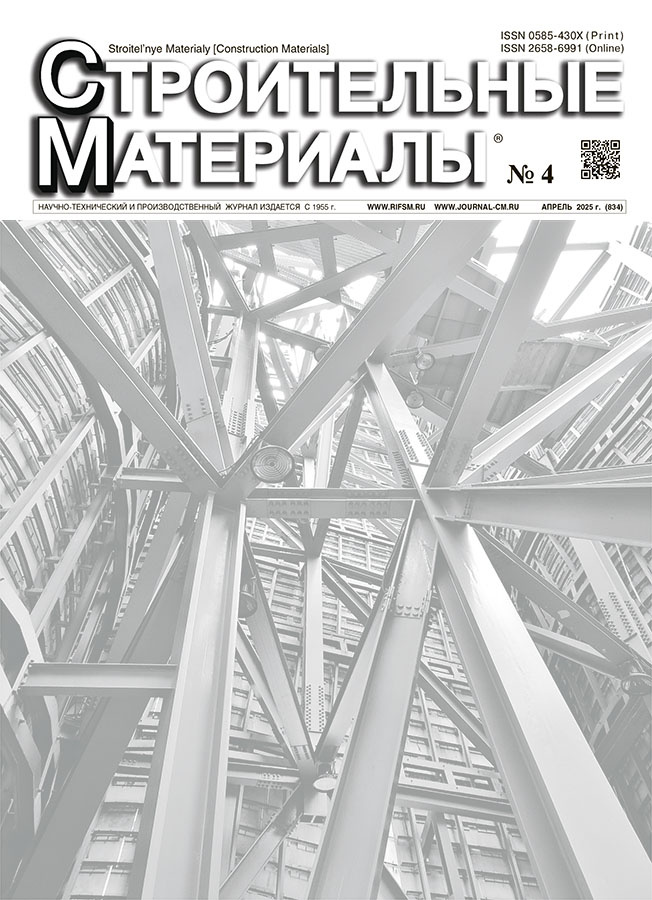Prospect of the large-format ceramic hollow-porous blocks on the base of siliceous gaize rocks production
- Authors: Zemlyanskaya А.G.1
-
Affiliations:
- Don State Technical University
- Issue: No 4 (2025)
- Pages: 59-66
- Section: Статьи
- URL: https://rjonco.com/0585-430X/article/view/682912
- DOI: https://doi.org/10.31659/0585-430X-2025-834-4-59-66
- ID: 682912
Cite item
Abstract
Since the end of the last century, construction industry enterprises have been in constant search for solutions to increase the products thermal protection properties, as achieving buildings normative energy saving is possible, among other, due to the provision of wall materials increased thermal insulation characteristics. These requirements can be met by using ceramic large-format hollow-porous blocks of average density 750–800 kg/m3 and thermal conductivity coefficient 0.7–0.1 W/(m.oC) with compressive strength at least 10–15 MPa in masonry walls. The high cost of such blocks of high-quality clay restrains their mass introduction into construction. It is possible to reduce the cost of blocks if we use common siliceous gaize rocks and coal industry waste as the main charge components. Clay gaize from the Rostov region and coal sludge from the Obukhovskaya CPP were studied in this work. Microscopic studies, X-ray phase analysis and thermocrafting have shown the potential suitability of this raw material for the production of porous ceramics. The study of the fired laboratory samples properties confirmed the possibility of obtaining highly porous durable ceramic stone. The conclusion: continuation of research in order to obtain full-format ceramic wall materials in production conditions is promising.
Full Text
About the authors
А. G. Zemlyanskaya
Don State Technical University
Author for correspondence.
Email: azemlyanskaya@donstu.ru
Docent
Russian Federation, 1, Gagarina Square, Rostov-on-Don, 344010References
- Uzhakov K.M., Kotlyar V.D. Clinker high-hollow ceramic stones: prospects for technology and application. Stroitel’nye Materialy [Construction Materials]. 2024. No. 4, pp. 49–54. (In Russian). EDN: RXBGJP. https://doi.org/10.31659/0585-430X-2024-823-4-49-54
- Ponomarev O.I., Lomova L.M., Komov V.M. Use of hollow porous stone and brick in construction. Stroitel’nye Materialy [Construction Materials]. 1999. No. 2, pp. 22–23. (In Russian). EDN: JQMWMI
- Gabidullin M.G., Gabidullina A.N. Calculation and graphic method for developing basic indicators of gas ceramic properties using the “technological efficiency coefficient”. Izvestiya KGACU. 2012. No. 4, pp. 285–295. (In Russian). EDN: PMEARV
- Orlovich R.B., Gorshkov A.S., Zimin S.S. Application of stones of high voidage in the facing layer of the multilayer walls. Inzhenerno-Stroitel’niy Zhurnal. 2013. No. 8, pp. 14–23. (In Russian). EDN: RQAJQL. https://doi.org/10.5862/MCE.43.3
- Granovsky A.V. Can the laying of walls from ceramic hollow stone have plasticity? Promyshlennoe i Grazhdanskoe Stroitel’stvo. 2019. No. 7, pp. 77–82. (In Russian). EDN: GDIMFL. https://doi.org/10.33622/0869-7019.2019.07.77-82
- Dmitriev K.S. Development of a method for designing raw mixtures in aerated ceramics technology. Vestnik Grazhdanskix Inzhenerov. 2015. No. 4 (51), рp. 112–116. (In Russian). EDN: ULQEXP
- Goncharova O.V. Technology of application of “warm” ceramics. Book of materials of the conference «Modern technologies in construction. Theory and practice». 2016. Vol. 1, pp. 236–241. (In Russian). EDN: XCRZST
- Yatsenko N.D., Vilbitskaya A.I. Formation of the structure and properties of effective wall ceramics based on waste from metallurgical production. Izvestiya of Higher Educational Institutions. North Caucasus Region. Technical Sciences. 2019. No. 2 (202), pp. 43–47. (In Russian). EDN: RTGDRH. https://doi.org/10.17213/0321-2653-2019-2-43-47
- Kotlyar V. D., Terekhina Yu. V. Mineralogical, chemical and structural features of opoka-like opal-cristobalite rocks as raw materials for the construction industry. Izvestiya Tomsk Polytechnic University. Inzhiniring Georesursov. 2023. Vol. 334. No. 1, pp. 145–155. (In Russian). EDN: UQFALB. https://doi.org/10.18799/24131830/2023/1/3852
- Zemlyanskaya A.G., Lapunova K.A., Semenova M. Yu. Dry masonry mixtures based on siliceous opal-cristobalite rocks for clinker bricks. Construction Materials and Products. 2024. Vol. 7. No. 2. EDN: GNBTWP. https://doi.org/10.58224/2618-7183-2024-7-2-5
- Kotlyar V.D., Terekhina Yu.V. Classification features and characteristics of opal-cristobalite opoka-like rocks as raw materials for wall ceramics. Stroitel’nye Materialy [Construction Materials]. 2022. No. 4, pp. 25–30. (In Russian). EDN: CJYTEC. https://doi.org/10.31659/0585-430X-2022-801-4-25-30
- Zabalueva T.R. Istoriya Arkhitektury i Stroitel’noi Tekhniki [History of architecture and construction technology.]. Moscow: Eksmo. 2007. 736 p. EDN: QNNCKF.
- Kotlyar V.D., Yavruyan H.S. Wall ceramic products based on finely dispersed products of waste heap processing. Stroitel’nye Materialy [Construction Materials]. 2017. No. 4, pp. 38–41. (In Russian). EDN: YNESDH. https://doi.org/10.31659/0585-430X-2017-747-4-38-41
- Abdrakhimov V.Z., Nikulina E.Yu., Abdrakhimova E.S. Innovative trends on the use of waste fuel and energy complex in the production of ceramic materials. Izvestiya of Higher Educational Institutions. Сonstruction. 2015. No. 9, pp. 31–44. (In Russian). EDN: VJKAHH.
- Kotlyar V.D., Ustinov A.V., Kovalev V.Yu., Terekhina Yu.V., Kotlyar A.V. Ceramic stones of compression molding based on flasks and waste coal enrichment. Stroitel’nye Materialy [Construction Materials]. 2013. No. 4, pp. 44–48. (In Russian). EDN: QBDVKX
Supplementary files

















